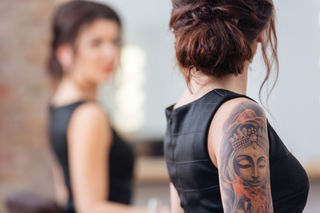What People Really Think About Women with Tattoos
Body art might cause people to jump to conclusions.
Posted Apr 08, 2018

Last year, a good friend of mine, radio host Mike Opelka, visited the 18th Annual Philadelphia “Tattoo Arts Convention,” which he writes about as spotlighting both skin art and “tattoo regret” — which he describes as a “real thing.”[i] As he circulated through the booths, he spoke with many people who described the pain involved in getting a tattoo, particularly in sensitive areas of the body, such as the chest. He also met people who described the desire for tattoo corrections, updates, and, yes, removal.
People remove tattoos for a variety of reasons. They are no longer with the high-school sweetheart whose name is plastered on their upper arm. They are tired of trying to cover up images they thought were cool 20 years ago. Or, they have simply decided the body art no longer fits their image, lifestyle, or religious beliefs.[ii]
Yet what about those who choose to showcase their often elaborate, intricate body art to the world? How are tattoos viewed today? And is there a difference between the way we view tattoos on women versus men? Research has some answers.
Are Tattoos Still Taboo?
The public perception of tattoos has evolved over the years. No longer are they exclusively viewed as symbols of nonconformity, rebelliousness, or gang activity. Someone with a visible tattoo 30 years ago was perceived very differently than he or she would be today. Today, you might not think twice about the inked barista taking your coffee order, or the retail store clerk with a rose tattoo on her wrist helping you put together an outfit for a job interview.
Obviously, when viewing body art, there is a major difference in first impression on your assessment of a small butterfly on the ankle versus a skull-and-crossbones on the forehead. Yet assuming one has inked memorialization in moderation, tattoos today are often conversation starters. You might inquire about the meaning behind an artistic scene or a scriptural passage someone is displaying to the world.
Yet when it comes to gauging romantic receptivity, the intentions of women showcasing visible tattoos are subject to serious misinterpretation.
Perceptions of Promiscuity and Power
Both women and men run the risk of being unfairly judged by what they show the world, from clothing to hairstyle to tattoos. In some cases, women are judged differently than men.
Research indicates that tattoos may send the wrong signal when it comes to judging sexual receptivity. Research indicates that men may misperceive tattooed women as more sexually responsive. This leads to approach behavior, potentially with false hopes of sexual activity.
Research by Nicolas Guéguen (2013) found that a man will approach a woman with a tattoo over one without — and faster.[iii] The study examined the approach behavior of men to women lying on a well-known beach. The women were reading, lying flat on their stomachs, some with a tattoo prominently displayed on their lower backs, some without.
Men were more likely to approach the women with tattoos — not because they found the tattooed women to be more attractive, but because they believed the tattooed women would be more likely to have sex on the first date.
Previous research by Hawkes et al. (2004) indicated negative attitudes towards women with visible tattoos.[iv] This negative evaluation was held even by study participants who had tattoos themselves. Yet there were other significant personality predictions that appeared to depend on the body art (or lack thereof) of the evaluator: Tattooed men rated tattooed women as more powerful and active than tattoo-less counterparts. Women viewed tattooed women as more powerful and less passive than their clear-skinned counterparts, whether or not they had a tattoo themselves. In other words, women viewed other women with tattoos less positively, yet rated them as more powerful.
The Individual Beneath the Ink
The tendency of people to jump to conclusions based solely on appearance is a byproduct of any visible type of ornamentation, from body art, to clothing, to hairstyle, as well as many other observable characteristics.
As my friend learned at the Philadelphia convention, people seek tattoos (as well as their removal) for different reasons. When judging the character, and receptiveness, of individuals with tattoos, it is important to resist the temptation to rely on stereotypes or reflexive assumptions. Only when we know about the incentive behind the ink, and the desire for the design, can we discover the person behind the persona.
References
[i]https://www.theblaze.com/news/2016/02/16/philadelphias-tattoo-arts-convention-spotlights-skin-art-and-tattoo-regret-its-a-real-thing
[ii]https://www.gotquestions.org/tattoos-sin.html
[iii]Nicolas Guéguen, "Effects of a tattoo on men’s behavior and attitudes towards women: An experimental field study." Archives of Sexual Behavior 42, no. 8 (2013): 1517-1524.
[iv]Daina Hawkes, Charlene Y. Senn, and Chantal Thorn, "Factors That Influence Attitudes Toward Women With Tattoos." Sex Roles 50, no. 9-10 (2004): 593-604.





















